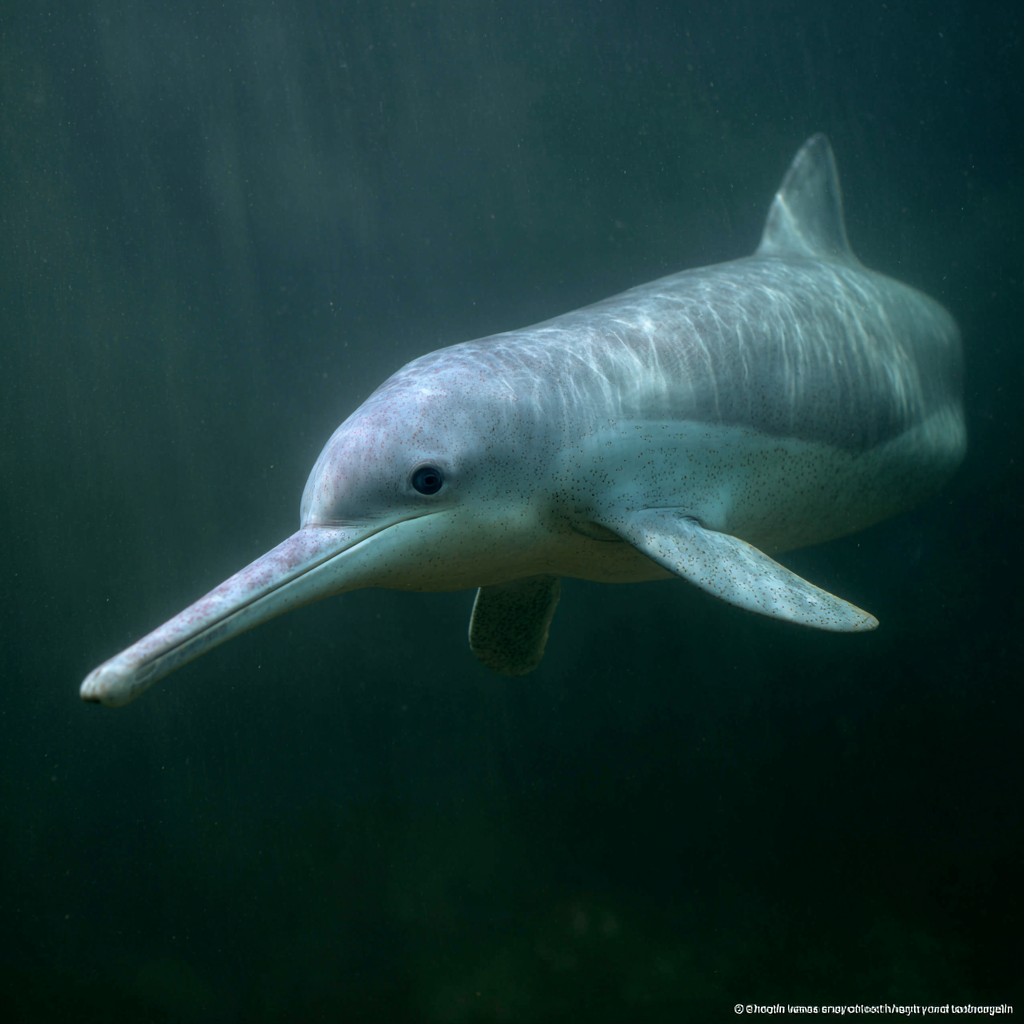Baiji
The Goddess of the Yangtze
The Baiji—known in Chinese as the "white-flag dolphin" for its distinctive triangular dorsal fin—once graced the waters of the Yangtze River for 20 million years. This pale blue-grey dolphin with its long, upturned beak and tiny eyes was perfectly adapted to life in one of the world's great rivers, navigating the murky waters through echolocation rather than sight. To the people of the Yangtze, the baiji was more than an animal; it was a spirit, a goddess, a symbol of peace and good fortune.
But by December 2006, after a comprehensive six-week survey of the entire historical range found not a single individual, scientists were forced to declare the baiji functionally extinct. It became the first cetacean species—and the first large vertebrate in over 50 years—to be driven to extinction by human activities. The goddess had fallen silent.
Physical Characteristics
Size & Appearance
- Length: 6-8 feet (1.8-2.4 m)
- Weight: 290-500 lbs (130-230 kg)
- Color: Pale blue-grey back, white belly
- Rostrum: Long, narrow, upturned beak
- Dorsal Fin: Small, triangular (resembling a white flag)
Life History
- Lifespan: Estimated 24 years
- Gestation: 10-11 months
- Calving Interval: Every 2 years
- Sexual Maturity: Females 6 years; males 4 years
- Eyes: Tiny, high-set; relied on echolocation
Distribution & Status
- Former Range: Middle & lower Yangtze River, China
- Habitat: Freshwater river systems, connecting lakes
- Family: Lipotidae
- Current Population: 0 (functionally extinct)
- Last Sighting: 2002

The baiji's pale blue-grey body, long upturned beak, and small triangular dorsal fin made it unmistakable—a species rendered functionally blind in the industrial cacophony of the modern Yangtze.
Legend and Cultural Reverence
For millennia, the Baiji was a creature of myth, a benevolent spirit of the river. In folklore, it was the reincarnation of a beautiful princess who, refusing to marry a man she did not love, threw herself into the Yangtze and was transformed.
Legend of the White-Flag Dolphin
To see a Baiji was considered a sign of peace and good fortune. Local fishermen would never deliberately harm one, believing it brought protection on the water. The dolphin's triangular dorsal fin, resembling a white flag waving just beneath the surface, was seen as a blessing from the river spirits—a symbol that became tragically ironic as the species surrendered to extinction.
This sacred status, however, proved to be a fragile shield against the physical realities of a rapidly industrializing China. Cultural reverence, no matter how deep, could not compete with the forces of modernization that would transform the Yangtze into one of the world's most polluted and industrialized rivers.

The Yangtze River that once sustained the baiji for 20 million years—a complex freshwater ecosystem that became an industrial highway choked with shipping traffic, dams, and pollution.
A Death by a Thousand Cuts
The Baiji's extinction was not the result of a single catastrophic event, but a slow and steady strangulation of its entire world. The threats came from every direction, each one compounding the others:
Dam Construction
The construction of massive dams, most notably the Three Gorges Dam, fragmented the baiji's habitat, altered the river's flow, and blocked the migration of its prey species. The natural rhythms of the river—its seasonal floods and flows—were replaced by engineered control systems that had no consideration for the species that had evolved alongside the river for millions of years.
Shipping Traffic and Noise
The Yangtze became one of the world's busiest aquatic highways. The constant noise from thousands of ships interfered with the dolphin's ability to navigate and hunt using echolocation. In the acoustic chaos of the industrial river, the baiji was effectively blind. Collisions with vessels became a frequent cause of death.
Pollution
The river was choked with industrial and agricultural pollution, poisoning both the dolphins and their food supply. Heavy metals, pesticides, and industrial waste accumulated in the river's sediments and bioaccumulated up the food chain.
Fishing Practices
The final, decisive blow came from the fishing industry. The Baiji was decimated by bycatch, becoming entangled and drowning in gillnets and snagged on rolling hook long-lines—a particularly destructive and indiscriminate fishing method that swept through the river like a dragnet.

The industrialized Yangtze River—dams, shipping traffic, fishing nets, and pollution created an impossible gauntlet for the baiji. By the time conservation efforts were seriously considered, it was already too late.
Too Little, Too Late
By the time conservation efforts were seriously considered in the 1980s and 90s, it was already too late. The population was too small, the threats too overwhelming, and the political will to enact the drastic, sweeping changes needed to save the river was absent.
The Final Survey
In 2006, an international team of scientists conducted an intensive six-week survey of the entire historical range of the baiji. Using visual observations and acoustic monitoring, they searched over 3,400 kilometers of the Yangtze River.
Result: Not a single baiji was found.
The species was declared functionally extinct—the first dolphin species to be driven to extinction by human activities, and the first cetacean to disappear from Earth since the Caribbean monk seal in the 1950s.
The Goddess of the Yangtze, a being that had survived for 20 million years through ice ages, continental shifts, and the rise and fall of entire ecosystems, was gone. Erased in less than half a century. Her story is now a permanent and somber part of the cetacean tapestry, a silent warning of the finality of extinction.
East of Center: Spirit of the Void
In the framework of the Medicine Wheel that organizes this project, the Baiji occupies the position of "East of Center"—the threshold between the realm of Spirit (East) and the Void (Center). It represents a spirit that has already crossed over, existing now only in memory, in myth, and as a warning.
The Baiji teaches us that extinction is not an abstraction. It is final, irreversible, and absolute. Once a species crosses that threshold, no amount of regret, no technological advancement, no conservation funding can bring it back. The spirit has departed, leaving only an absence—a hole in the web of life that can never be filled.
The baiji's extinction should haunt us. It should remind us that every species teetering on the edge—the vaquita, the North Atlantic right whale, the Māui dolphin—could follow the same path. The difference between survival and extinction is not fate; it is choice. The baiji's story is a call to action for every species that still swims, still breathes, still sings beneath the waves.
References
- IUCN Red List. Lipotes vexillifer (Baiji). https://www.iucnredlist.org/species/12119/50362206
- Turvey, S.T. et al. First human-caused extinction of a cetacean species? Biology Letters 3(5): 537-540 (2007). https://royalsocietypublishing.org/doi/10.1098/rsbl.2007.0292
- Turvey, S.T. Witness to Extinction: How We Failed to Save the Yangtze River Dolphin. Oxford University Press (2008).
- Turvey, S.T. et al. Spatial and temporal extinction dynamics in a freshwater cetacean. Proceedings of the Royal Society B 277: 3139-3147 (2010). https://royalsocietypublishing.org/doi/10.1098/rspb.2010.0584
- IUCN SSC Cetacean Specialist Group. Yangtze River Dolphin (Baiji). https://iucn-csg.org/baiji/
- Natural History Museum. The baiji: Why this extinct river dolphin still matters. https://www.nhm.ac.uk/discover/baiji-why-this-extinct-river-dolphin-still-matters.html
- Whale and Dolphin Conservation. Baiji (Chinese river dolphin). https://us.whales.org/whales-dolphins/baiji-chinese-river-dolphin/
- The Guardian. Yangtze river dolphin driven to extinction. August 8, 2007. https://www.theguardian.com/environment/2007/aug/08/endangeredspecies.china
- Discover Magazine. Is the Yangtze River Dolphin Gone Forever? June 3, 2023. https://www.discovermagazine.com/planet-earth/is-the-yangtze-river-dolphin-gone-forever